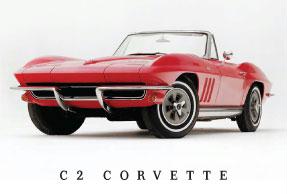

For almost 10 years, the Corvette had never received a substantial chassis overhaul, so this was one of the biggest changes to the second-generation C2 Corvette. That and the introduction of big-block V8 power and a new coupe model, which joined the convertible.
The Sting Ray Debuts
Zora Arkus-Duntov, chief engineer, was building a new chassis while head designer Bill Mitchell worked with his assistant Larry Shinoda to design a new body; most of the engines and the three-speed manual transmission carried over. The final product was labeled the Sting Ray. Although it was exceptionally attractive, the 1963 Corvette Sting Ray was outfitted with extraneous elements that offered nothing more than flare, including non-functional hood vents, pop-up headlamps and a split rear window that significantly diminished rear visibility. Either way, the Sting Ray was a huge hit and tens of thousands were sold. It also received many positive reviews from esteemed automotive publications like Motor Trend.
More Power, Less Flash

In 1964, the Corvette's decorative hood vents were done away with and the showy split rear window was upgraded to a full-width window. Following this, the 1965 Corvette received very minor exterior revisions, but big changes were happening under the hood. Four-wheel disc brakes were now standard equipment and a new 396-cubic inch big-block V8 was introduced; the 327-cubic inch V8 that had powered the Corvette for over a decade was still the base engine. Just one year later a slightly larger 427-cubic inch big-block V8 replaced the 396 and could produce unheard of power ratings. An L30 engine option generated 390 hp, and at max an L72 option pumped out a whooping 400 hp. Options on the 1965 Corvette included a telescopic steering wheel, headrests and a Wonderbar auto-tuning AM radio.
The Final C2s & L88 Sting Ray
1967 was the last model year for the C2 cycle. '67 Corvettes had restyled fender vents, newly styled rectangular back-up lamps and, for the first time, all four taillights were red. The L88 engine option also appeared in 1967; it featured a four-barrel carburetor and had a compression ratio of 12.5-to-1. It was designed specifically for racing and came with a hefty price tag; as a result only 20 of the engines were ever installed. Today, the L88 Sting Ray is one of the rarest and most sought after models. The L68 and L71 were also new and notable engine options that year; the L68 produced 400 hp and the L71 was rated at 435 hp. Both featured a Holley triple two-barrel carburetor, also referred to as "Tri-Power."
While many automotive historians would say the Corvette was at its peak near the end of its second cycle, Chevy would give it a major styling overhaul in the near future.
- 1963 - First time offered in a Coupe (split window fastback model - 1963 MY only) First major restyling of the Corvette. First time with hidden headlights.
- 1964 - Corvette replaced split window with full rear window, restyled roof vents, and removed fake hood vents.
- 1965 - Corvette gets optional 'Big Block' 396 V8, standard 4 wheel disc brakes, side exhaust option, and telescopic steering wheel.
- 1966 - Corvette gets optional 427 V8 engine with power bulge hood.
- 1967 - Subtle styling refinements.
Contact Information
Make an Inquiry
* Indicates a required field
Hours
- Monday 8:00 am - 9:00 pm
- Tuesday 8:00 am - 9:00 pm
- Wednesday 8:00 am - 9:00 pm
- Thursday 8:00 am - 9:00 pm
- Friday 8:00 am - 9:00 pm
- Saturday 8:00 am - 8:00 pm
- Sunday 10:00 am - 6:00 pm